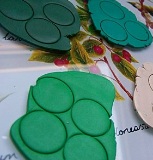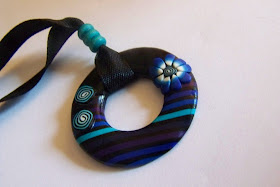Making this polymer clay cane is very simple... if you have a clay extruder! (about extruders for polymer clay, those with a screw mechanism are far easier to use than those with a simple piston to push on which need a lot of strengh!).
Choose 6 colors (for me greens and two contrasting colors, black and beige). This is better to use these contrasting colors, the extruder cane will have nicer patterns.
With a pasta machine or a rolling pin, flatten your colors ; then cut them into equal pieces (I usually use the extremity of my extruder as a cookie cutter to get even rounds).
Randomly combine these small rounds. Using the square disk of your clay extruder (mine is the Makins Professional Ultimate Clay Extruder, aluminium & screw mechanism, very nice, easy to use), you get a very long square extruder cane. It looks better if you turn quite slowly and if the polymer clay is not too cold. With cold polymer clay or by turning too fast you will get an extruder cane with "broken up" corners (that's not a real problem as it looks pretty also but it's better to have an extruder cane with smooth corners for our final cane).
Cut this long extruder cane into equal pieces (use a ruler if needed!) and combine the different parts.
Make the different parts stick together, without distorting them. Gently press the different sides of the cane as if you wanted to reduce it. You can also use a small rolling pin for the large sides.
Then you just have to wrap your rectangular cane into one nice matching color (here I chose black).
Flatten the color you want to use with your pasta machine or a rolling pin. Putting your rectangular extruder cane on the flattened sheet, use it as a template to cut 4 pieces (one for each side) in it.
Stick these 4 pieces on each side of your rectangular cane, be careful for air bubbles (make sure you press from the middle to the edge).
"Merge" the different pieces by rubbing the junctions with shrink-wrap or using latex gloves.

















